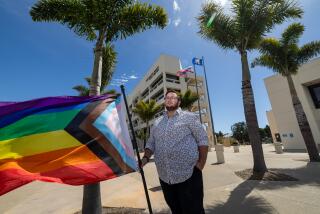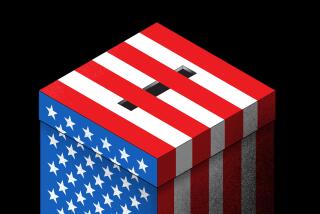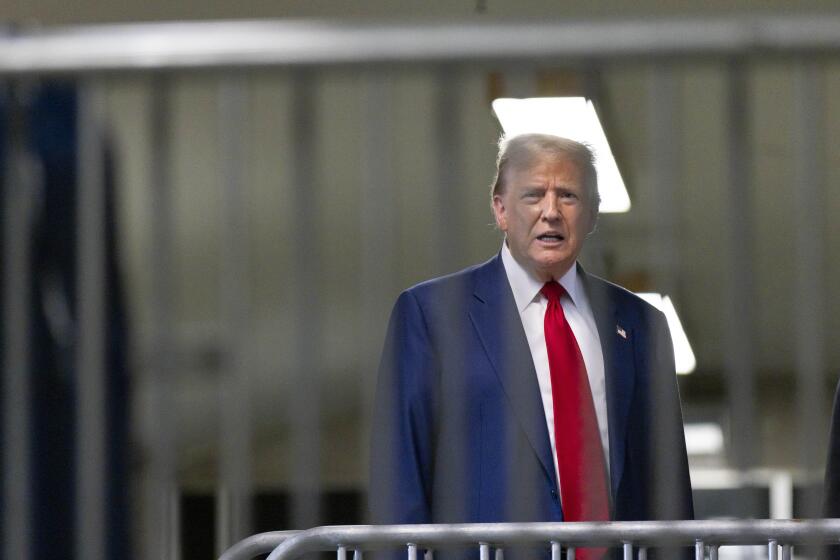Democrats hope first-time voters of 2008 turn out again
Jordan Love, 22, was standing outside his home with his pit bull Duke when he was approached the other day by a Democratic volunteer canvassing his Carson neighborhood. Love had voted for the first time in 2008, inspired by Barack Obama’s campaign, and that has made him a target in 2010.
Lori Noflin, the volunteer, urged him to cast a ballot again this fall and would only walk away after Love signed a card pledging to vote in November.
Voters like Love — first-time and sometimes voters — are a vital voting bloc for Democratic gubernatorial nominee Jerry Brown and incumbent Sen. Barbara Boxer in their election bids, according to political observers in both parties. Both candidates are in dead-heat races, and their fates could rest on these voters, a mercurial bunch whose turnout potential is unpredictable.
“The Obama candidacy motivated a lot of new voters....Those voters are critically important to the Brown campaign and the Boxer campaign,” said Darry Sragow, a Democratic consultant. In 2008, “their participation clearly reflected a passion, they were attracted to a cause….The problem for campaigns is you can’t clone that.”
In 2008, as many as 20 million first-time voters cast ballots across the nation; many of them were young or minority voters. More than 1 million were in California. The bulk of those voters cast ballots for Obama, and Democrats looked optimistically toward a new generation of supporters.
Yet first-time voters by definition have no ingrained habit of casting ballots year in and year out. Now, with sentiment running against their candidates, Democratic strategists say their success in congressional and gubernatorial races across the nation hinges on how many of these voters they can persuade to return to the polls without Obama at the top of the ticket.
“We’ve got those 20 million first-time voters who don’t have a political history of voting, they don’t have a strong incentive to vote in 2010, they don’t have a lot of information about the candidates,” said David Plouffe, Obama’s campaign manager who is advising the White House about the midterm election strategy.
Plouffe, speaking at a “Generation 44” fundraiser for young Obama supporters at a nightclub near the Capitol Records building in Hollywood this month, said their participation is vital to Democratic efforts.
“If we can just get a small increment in their likely participation, that will win us races,” he said. “You can say that’s on the margins; I say that’s where elections are won.”
But all sides acknowledge that motivating these voters will be an uphill battle.
Turnout is always highest during presidential elections, and drops precipitously in the intervening years. In the last two presidential elections, in 2004 and 2008, nearly eight out of 10 registered voters cast ballots, according to the California Secretary of State’s office. In the most recent midterms, turnout was lower: 56% of registered voters in 2006, and nearly 51% in 2002.
The Brown campaign, which declined to disclose its efforts to sway these voters, recognizes the challenges it faces.
“There is historically a substantial drop-off from presidential to non-presidential years. I don’t think the percent of voters that turned out in ’08 is going to turn out in 2010. That’s historical reality,” said Sterling Clifford, a Brown spokesman. “Certainly, a substantial portion of 2008 first-time voters are Democrats or decline-to-states who lean Democratic, and we have an interest in making sure they come out a second time.”
The Whitman campaign is trying to peel away some of these voters with an aggressive effort targeting college students, young professionals and other constituencies that traditionally trend Democratic.
“This is part of Meg’s comprehensive effort to reach out and engage the many different constituencies across California,” said Sarah Pompei, a spokeswoman for Whitman. “A big part of that will be to engage students and young professionals during this election. The No. 1 issue facing young adults and students, just like most Californians actually, is the need for quality jobs.”
These voters are in part an open target because it has been a rough two years since Obama’s election, with the country struggling with an ongoing recession marked by high unemployment and continuing home foreclosures.
“That’s actually one of the biggest problems, a lack of energy and enthusiasm,” said Jeff Lassauske, a 28-year-old from Pasadena who was at the Generation 44 event. “A lot of people are disappointed. People had high expectations.”
Jack Pitney, a government professor at Claremont McKenna College and a former national GOP official, said the attempt to attract dispirited voters is further complicated by California’s Democratic ticket, which features politicians older than the parents of many first-time voters.
“Democrats really need to gin up that support, and that’s really difficult without Barack Obama at the top of ticket,” Pitney said. “ ‘Vote for the guy who was governor before you were born’ is not really an exciting message for first-time voters.”
A key strategy among Democrats is to make the election about Obama, who retains a higher measure of goodwill in California than in the rest of the nation — and remains more popular than other California political figures. Obama has already made multiple fundraising appearances for Boxer, and strategists said they expect to see him back in the fall.
“I’d be very surprised is we don’t see Barack Obama here in California really rolling up his sleeves, going to college campuses, to African American neighborhoods, going to areas that were really his strength in ‘08,” said Allan Hoffenblum, a former Republican strategist and publisher of the nonpartisan California Target Book.
Organizing For America, the Democrats’ national get-out-the-vote apparatus, has made the president the centerpiece of its message to voters. On a recent Saturday, organizers told volunteers to make Obama and his agenda central to their pitch as they reached out to 2008’s first-time voters in their homes and on the phone. More than 330 volunteers sought out 6,000 first-time voters in California that day, and talked to 900 of them.
“We are obviously focusing on first-time 2008 voters… making sure these people are as fired up and ready to go, and get to the polls in 2010,” Phil Gaskin, a regional field director, told a handful of volunteers gathered at Lori Noflin’s airy Carson home, preparing to canvas neighborhoods and make calls from a phone bank. “It’s a whole campaign to keep the president linked to these voters, even though he’s not running this year. It’s a very, very cool strategy.”
A volunteer asked: “Is there anything to mention about the candidates running? Boxer? Brown?”
“No,” Gaskin replied, “we may do that later on.”
For Jordan Love, Obama may be enough. Although attracted by the president’s call for change, he acknowledged that progress has been slow since then.
“You know, he’s done some good things,” Love said. “It’s going to take time. He can’t do everything overnight.”
More to Read
Get the L.A. Times Politics newsletter
Deeply reported insights into legislation, politics and policy from Sacramento, Washington and beyond. In your inbox three times per week.
You may occasionally receive promotional content from the Los Angeles Times.







